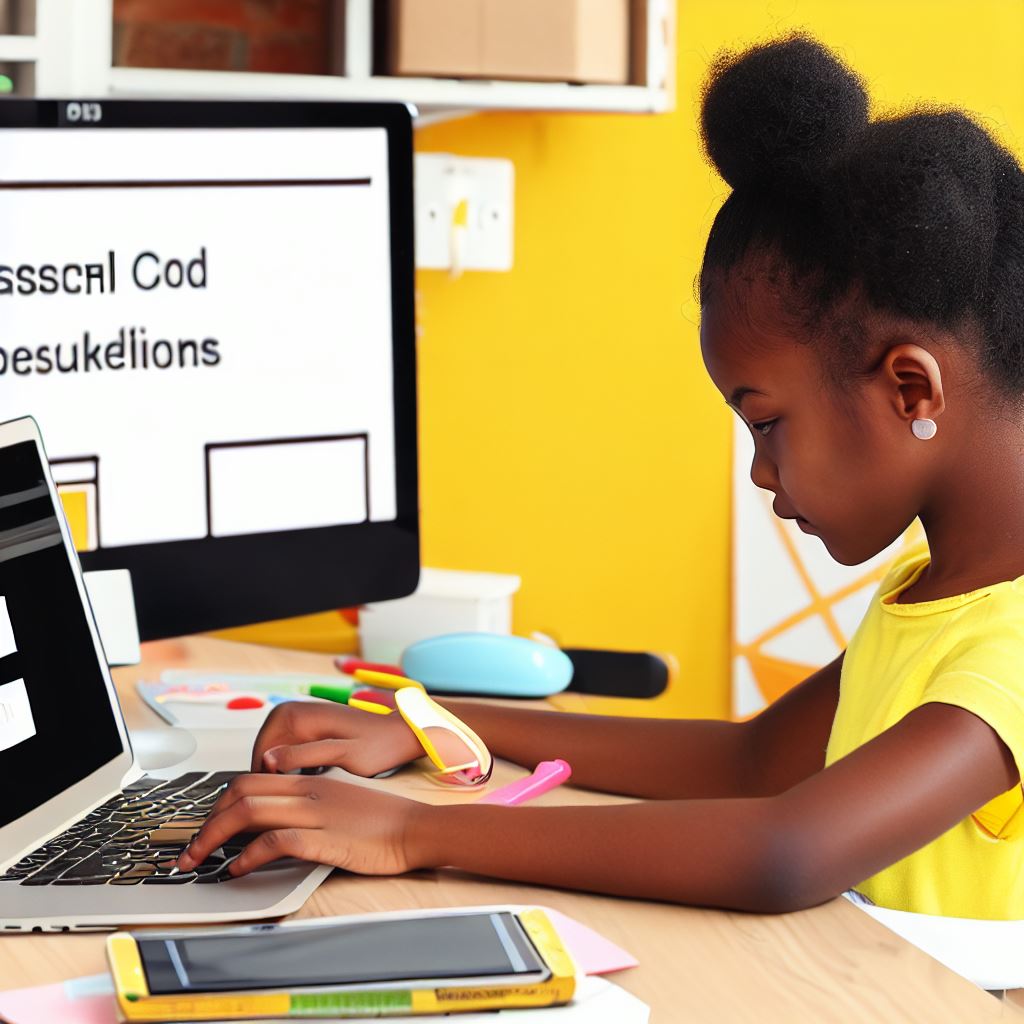Introduction
Teaching coding to kids in 2023 is incredibly important as it equips them with essential skills for the future.
By introducing coding at a young age, children develop problem-solving abilities and logical thinking.
Utilizing free coding websites significantly enhances this learning experience.
These platforms provide accessible and interactive tools, ensuring that every child has the opportunity to explore and understand coding concepts.
Benefits of Coding for Kids
Coding is not just for adults anymore. In fact, teaching coding to kids has become increasingly popular in recent years.
This is because coding can offer numerous benefits for kids, helping them develop important cognitive and problem-solving skills while fostering creativity and innovation.
Here are some of the key benefits of coding for kids:
1. Development of Cognitive and Problem-Solving Skills
Coding requires logical thinking and analysis, which helps kids enhance their cognitive abilities.
It encourages them to break down complex problems into smaller, more manageable parts.
Through coding, kids learn to think critically and solve problems systematically, improving their problem-solving skills.
2. Foster Creativity and Innovation
Coding empowers kids to unleash their creativity by designing and building their own projects.
It encourages them to think outside the box and come up with unique solutions to challenges.
By coding, children learn to think creatively and develop innovative ideas, essential skills for the future.
3. Enhance Mathematical and Computational Thinking
Coding involves using mathematical concepts, such as logic, patterns, and algorithms.
By practicing coding, kids strengthen their understanding of math and computational thinking.
Tech Consulting Tailored to Your Coding Journey
Get expert guidance in coding with a personalized consultation. Receive unique, actionable insights delivered in 1-3 business days.
Get StartedThey learn how to apply math concepts in real-world scenarios, making math more relevant and engaging.
4. Improve Focus and Attention to Detail
Coding requires kids to pay attention to every detail and write precise instructions.
It helps them improve their focus and concentration as they debug and refine their code.
By coding, children become more detail-oriented, which can benefit them in various aspects of life.
5. Promote Collaboration and Teamwork
Coding often involves working in teams, encouraging kids to collaborate and share ideas.
It teaches them how to build upon each other’s strengths and learn from one another.
Through collaborative coding projects, children develop essential teamwork skills.
6. Enhance Future Career Opportunities
In a technology-driven world, coding skills are highly sought after by employers.
Learning coding at an early age provides kids with an advantage in future career opportunities.
It opens doors to a wide range of professions, such as software development, data science, and robotics.
7. Boost Confidence and Resilience
Successfully coding a project can boost a child’s confidence and self-esteem.
It teaches them to be resilient, as coding often involves trial and error.
Coding helps kids develop a growth mindset, believing that mistakes are opportunities for learning and improvement.
Therefore, teaching kids how to code offers numerous benefits.
Build Your Vision, Perfectly Tailored
Get a custom-built website or application that matches your vision and needs. Stand out from the crowd with a solution designed just for you—professional, scalable, and seamless.
Get StartedIt helps develop cognitive and problem-solving skills, fosters creativity and innovation, enhances mathematical thinking, improves focus and attention to detail, promotes collaboration and teamwork, enhances future career opportunities, and boosts confidence and resilience.
Introducing coding to children can have a profound impact on their overall development and set them up for success in the future.
Read: 9 Coding Programs to Build Your Portfolio Projects
Criteria for Selecting Free Coding Websites
When it comes to teaching kids coding, choosing the right website is crucial.
There are several factors to consider before making a selection.
Here are the key criteria to look for:
A. User-Friendly Interfaces and Age-Appropriate Content
- Ensure the coding website has a simple and intuitive interface that is easy for kids to navigate.
- Look for websites that offer age-appropriate content to keep children engaged and motivated.
- Intuitive design and layout will enable kids to understand the coding concepts more effectively.
- Age-appropriate content ensures that children can comprehend the material and progress at their own pace.
B. Engaging and Interactive Coding Activities
- Choose websites that provide interactive coding activities to make the learning process fun and exciting.
- Interactive games and challenges can spark children’s interest in coding and encourage them to continue learning.
- The activities should be designed to engage kids actively, allowing them to practice their coding skills hands-on.
- Look for websites that offer a variety of coding activities, including puzzles, quizzes, and projects, to keep kids interested.
C. Comprehensive Tutorials and Step-by-Step Guidance
- Ensure that the coding website provides comprehensive tutorials that explain coding concepts in a clear and concise manner.
- Step-by-step guidance is crucial for kids to understand the coding process and progress smoothly.
- Look for websites that break down complex concepts into manageable chunks, making it easier for children to grasp.
- Clear explanations and examples will help kids build a strong foundation in coding and develop problem-solving skills.
By considering these criteria, you can find the best free coding websites for kids.
These websites offer user-friendly interfaces, age-appropriate content, engaging activities, comprehensive tutorials, and step-by-step guidance.
When children have access to such websites, learning coding becomes enjoyable and rewarding.
They will develop critical thinking, logical reasoning, and problem-solving skills while having fun.
So, choose wisely and embark on a coding journey with your child today!
Read: The Pros and Cons of Free Vs Paid Coding Courses

Top Free Coding Websites for Kids in 2023
1. Scratch
Scratch is a popular coding website that allows kids to create interactive stories, games, and animations.
It offers a block-based programming language, making it easy and fun for beginners.
Optimize Your Profile, Get Noticed
Make your resume and LinkedIn stand out to employers with a profile that highlights your technical skills and project experience. Elevate your career with a polished and professional presence.
Get NoticedScratch is suitable for kids aged 8 and above, as well as teenagers and even adults who are new to coding.
It caters to a wide range of skill levels, from beginners to more advanced users.
One standout feature of Scratch is its online community, where kids can share their projects, collaborate with others, and get feedback from a supportive community of fellow coders.
2. Code.org
Code.org is an educational platform that aims to make coding accessible to all students, especially those from underrepresented groups.
It offers a wide range of coding tutorials and activities.
The website caters to kids of all ages, from elementary school to high school.
It provides resources for both beginners and more experienced coders, allowing kids to progress at their own pace.
Code.org has a unique aspect called “Hour of Code,” which encourages kids to spend at least one hour learning to code.
It also features a diverse selection of coding tutorials, including themed ones based on popular games and movies.
3. Tynker
Tynker is another coding website designed specifically for kids.
It offers various coding activities, including puzzles, games, and interactive tutorials that teach fundamental coding concepts.
Tynker is suitable for kids aged 7 and above. It caters to beginners as well as more advanced coders, with progressively challenging activities that help kids build their coding skills over time.
One standout aspect of Tynker is its focus on creativity.
The website allows kids to not only learn coding but also create their own games and projects using its drag-and-drop coding interface.
4. Kodable
Kodable is a coding website that introduces young kids to the basics of programming through a series of interactive games.
It uses a simple drag-and-drop interface to teach coding concepts.
Kodable is designed for kids aged 4 to 10, making it perfect for preschoolers and elementary school students.
It starts with simple concepts like sequencing and loops and gradually progresses to more advanced topics.
An interesting feature of Kodable is its curriculum alignment, making it a valuable resource for teachers who want to incorporate coding into their lesson plans.
It also offers comprehensive progress tracking for parents and educators.
5. LightBot
LightBot is a coding website that uses a puzzle-based approach to teach kids programming logic.
The goal is to guide a robot through a series of challenges using programming commands.
LightBot is suitable for kids aged 9 and above, including teenagers and adults who want to improve their coding skills.
It caters to both beginners and experienced coders, providing challenges for different skill levels.
A standout feature of LightBot is its emphasis on problem-solving and critical thinking.
The game-like interface engages kids and encourages them to find creative solutions to each level’s puzzles.
Most importantly, there are several top free coding websites available for kids in 2023.
Scratch, Code.org, Tynker, Kodable, and LightBot offer unique features and cater to various age ranges and skill levels.
These websites provide an excellent platform for kids to learn and develop coding skills in a fun and engaging way.
Read: Coding vs Template: A Quick Primer for Students
Tips for Parents or Guardians
When it comes to helping your child learn coding through websites, creating a positive learning environment is crucial.
Here are some tips to make the process enjoyable and effective:
- Set up a dedicated workspace for your child where they can comfortably use the coding websites.
- Make sure the workspace is free from distractions to help your child focus on coding tasks.
- Encourage your child to take breaks during coding sessions to prevent fatigue or frustration.
- Support your child’s curiosity by answering their questions about coding concepts or techniques.
- Explore the coding websites together with your child to understand their features and activities.
- Monitor your child’s progress and celebrate their achievements to boost their confidence.
- Keep communication open with your child’s coding teacher or instructor to stay updated on their learning journey.
- Participate in coding events or competitions to motivate and inspire your child.
- Encourage your child to collaborate with other kids using coding websites to enhance their social skills.
- Celebrate mistakes as learning opportunities and teach your child the importance of resilience in coding.
Additional Offline Activities to Complement Online Coding Learning
While coding websites provide an excellent platform for learning, it is essential to engage in offline activities that complement and reinforce coding skills.
Here are some suggestions:
- Encourage your child to read books about coding or biographies of influential programmers.
- Introduce your child to educational board games or puzzles related to logic and problem-solving.
- Organize coding-themed playdates or gatherings where children can code together and learn from one another.
- Visit local science museums or technology centers that offer interactive exhibits on coding.
- Enroll your child in coding workshops or camps during school breaks to enhance their hands-on coding experience.
- Encourage your child to share their coding projects or creations with family and friends.
- Involve your child in real-life coding projects, such as creating a website or a simple mobile app.
- Support your child in attending coding meetups or clubs where they can connect with like-minded individuals.
- Integrate coding activities into everyday tasks, such as creating a chore chart using coding concepts.
- Encourage your child to teach coding to younger siblings or friends, reinforcing their own learning.
By implementing these tips and engaging in complementary offline activities, parents and guardians can optimize their child’s coding learning journey.
Remember to nurture their passion, curiosity, and creativity while providing a supportive and stimulating environment.
Happy coding!
Read: Master Python with These Free Online Platforms
Conclusion
Introducing kids to coding through free coding websites is of utmost importance.
These websites provide a variety of options that are readily available on the internet in 2023.
Parents, teachers, and kids should explore these websites to foster coding skills.
By starting early and using free coding websites, kids can develop problem-solving abilities, critical thinking skills, and creativity.
They can learn to build websites, design games, and create apps, which are valuable skills in the digital age.
The availability of numerous coding websites for kids in 2023 ensures that there is something suitable for every child’s learning style and interest.
From interactive tutorials to coding challenges and projects, these websites offer a diverse range of resources.
Parents and teachers should encourage their kids to explore these websites to discover their passion for coding.
It can potentially lead to future career opportunities in the ever-expanding tech industry.
Moreover, coding fosters important skills such as collaboration, perseverance, and resilience, which are essential for success in the 21st century.
These free coding websites provide a safe and supportive environment for kids to experiment, learn, and grow.
Free coding websites are invaluable resources for kids to acquire coding skills and develop crucial abilities for the future.
It is an investment in their educational and personal development that can open doors to exciting opportunities down the line.
So, let’s encourage kids to explore the world of coding through these accessible platforms.




